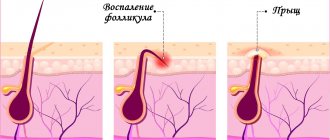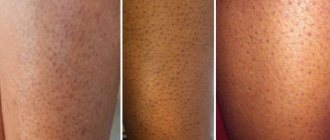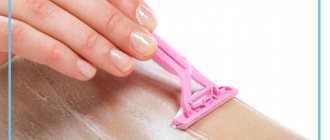Why do acne appear after waxing?
Ulcers, irritations, and swellings form for various reasons.
It is necessary to familiarize yourself with all possible factors in order to eliminate them in the future. So, the causes of acne after depilation:
- Very sensitive skin. The epidermis has increased sensitivity to external irritants. Any aggressive effect on the skin leads to a state of irritation. Girls who have just started hair removal often face this problem. Over time, the dermis may get used to it and acne will not appear, but it happens that the skin continues to react to the procedure with inflammation for a long time.
- Neglect of hygiene and sterility standards. During depilation, especially where hair is removed along with the root, the upper skin layer is broken, the holes where the hairs were remain open. Microbes instantly penetrate the damaged layers of the epidermis and begin to multiply. It is very important that during the process everything is sterile and disinfected.
- Allergic reaction. The body may react to the hair removal material or the procedure itself with an allergy. Pustules appear after sugaring, waxing, chemical epilator cream, as a reaction to the material. This allergy may be accompanied by itching and swelling of the epilated areas.
- Infection. During the procedure, there is a risk of infection, causing purulent formations on the skin. Harmful microorganisms can be found anywhere: on the hands of the master, auxiliary tools, in the wax itself (if dirty hands were immersed in it).
- Hormonal disorders. Due to hormonal imbalance, pustules often appear in the bikini area, groin, and on the face in the lower part. Aggressive effects on the skin further stimulate their reproduction.
- Clogged hair pores. Some cosmetics used after depilation (creams, lotions) clog the hair holes, preventing them from healing naturally. Inflammatory processes begin inside the pores, resulting in ulcers.
Pros and cons of the method
Laser hair removal has a huge number of advantages and virtually no disadvantages. The advantages of the technique include the following factors:
- the procedure is painless, since the modern equipment used is equipped with special cooling systems;
- high level of safety - infection is excluded, tissues are restored quickly;
- simultaneous rejuvenating effect - the laser stimulates the production of its own collagen and elastin, which helps to increase skin elasticity;
- the formation of ingrown hairs is excluded;
- the highest effect among other hair removal procedures – smooth skin without irritation;
- long-term or permanent results.
There are few disadvantages to laser hair removal. To a greater extent, these include a large list of contraindications. The higher cost compared to other techniques rarely bothers patients, since there is no need to return to the procedure often.
Features of acne that occurs after depilation
Acne after hair removal varies in the nature of the rash. There are white pimples, red pimples with purulent contents, black dots, painful large bumps, and blisters.
They appear in any part of the body where depilation was performed.
Face
Some women remove hairs above the lip and in the chin area. Most often, a small pustular or red rash appears in this area. The skin on the face is tender and sensitive, reacts with irritation to external aggressive interference.
Armpits
Acne after shaving, waxing, sugaring or any other method most often occurs due to non-compliance with the rules of caring for the skin of the armpits after the procedure. Some people immediately apply antiperspirant to their armpits, which completely clogs the sockets of the hair follicles. This contributes to the appearance of blackheads, painful large pimples and redness.
Bikini
Irritation, pimples, ulcers on the pubic area after shaving are a very common occurrence. Trouble may appear in the intimate area after shaving, epilator cream, machine, wax, laser hair removal. The skin in the bikini area is also very sensitive and is constantly in contact with underwear. The cause of the reaction can be a variety of factors, from individual sensitivity to infection.
Legs
The skin on your feet is less sensitive. Purulent and red pimples after hair removal are mainly localized on the thighs, where the epidermis is thinner. The problem often occurs in the summer, when dust gets on exposed legs or a woman, without following the rules, sunbathes and swims in open water in the first days after depilation.
Indications
Laser treatment is recommended if you have excess facial hair. Most often, women prefer to get rid of such a defect as a mustache above the upper lip, but the technique is also used for men. Causes of excessive facial hair growth:
- hormonal imbalance – with abnormal testosterone production;
- hereditary predisposition;
- improper diet – passion for foods that contain a high percentage of carbohydrates;
- dysfunction of the endocrine system;
- hirsutism (increased hair growth of the androgenic type).
The appearance of a mustache above the upper lip can also be caused by certain types of decorative or skincare cosmetics that contain hormonal components.
Acne Treatment Methods
Treatment of acne after depilation can be divided into two types:
- Medication
- Traditional ways
Antibiotic ointments
Miramistin, Levomekol, Erythromycin, Tetracycline, Baneocin, Fusiderm - these drugs have a wide spectrum of action, fight harmful microorganisms, relieve inflammation, heal wounds and ulcers. They can be used to treat acne on the pubic area, legs, arms, face. Each ointment contains instructions, which indicate the rules of use and contraindications.
Healing anti-inflammatory ointments/creams
Radevit, Zenerit, Bepanten, D-panthenol, Boro Plus - these ointments and creams contain regenerating and healing components, quickly relieve redness, rashes, small pustules, swelling, itching.
Antibacterial solutions
Miramistin, Chlorhexidine, Hexicon, Furacilin, Chlorophyllipt, Hydrogen Peroxide - preparations in liquid form are intended for treating inflamed areas of the skin. All of them have a powerful antiseptic, bactericidal effect, and quickly relieve inflammatory processes.
Folk remedies for pimples after depilation
- If acne appears after shaving the intimate area, you can treat the skin with a weak solution of manganese immediately after the procedure and for a few days after. Potassium permanganate not only has antiseptic and anti-inflammatory properties, but also prevents hair growth. It is not recommended to use it in other areas, as the skin may darken slightly for a while.
- Aloe juice is an excellent remedy for any inflammation. You can make a compress out of it or simply lubricate irritated areas. Kalanchoe and plantain have the same healing properties.
- To prevent acne from occurring after sugaring, waxing, or an epilator (methods in which hair is removed from the roots), it is recommended to treat the skin with chamomile or calendula infusion.
- After shaving in the bikini area, legs or armpits, you can wipe the skin with a decoction of the string. The herb has antiallergic and antiseptic properties.
- Essential oils of eucalyptus, fir, lemongrass, saffron, and mint prevent inflammation. But they should be used diluted: for 10 drops of base oil (any cosmetic) 2 drops of essential oil.
- Pimples will not appear on your legs or there will be fewer of them if you powder your skin with baby powder immediately after depilation.
Complication of waxing
Let's start with the very first one - waxing. It is not uncommon for burns and irritation from hot wax to occur if the technique of the procedure is violated. Therefore, waxing hair at home is not always safe. The most common and unpleasant complication is a large number of ingrown hairs, which is associated with trauma to the skin when pulling out a hair and changing the direction of new growth. This leads to subcutaneous hair growth with the further addition of an inflammatory reaction. So-called folliculitis (inflammation of the hair follicle) occurs. They look like red “pimples” that are quite painful and itchy.
In addition, an infection can accompany folliculitis, which will lead to the formation of pus. This situation may require antibiotic therapy. The gold standard in the treatment of ingrown hairs and their complications (congestive inflammatory spots, pigmentation, scars) is phototherapy. More information about the problem of ingrown hairs can be found in the corresponding section.
How to prevent acne from occurring
- It is necessary to observe the correct technique: with a machine, hairs are shaved off according to hair growth, chemical cream cannot be kept on for longer than the specified time, when waxing, hairs are pulled out against hair growth, when sugaring according to hair growth.
- All personal care items should only be used by one person.
- To prevent acne from appearing after the depilation procedure, you must follow the rules of skin care.
- For the first 2–3 days, it is advisable to wear loose clothing made from natural fabrics.
- You should not frequently touch the epilated area with your hands for the first couple of days.
- After waxing, mechanical or sugar depilation, it is recommended to scrub the skin after 5 days to reduce the risk of ingrown hairs, which also cause inflammation.
- After the session, you should not use products containing alcohol.
- To prevent acne from appearing on sensitive skin, it should be treated in advance with antiseptic anti-inflammatory agents.
Progress of the procedure
The session for removing excess vegetation above the upper lip is carried out in stages:
- The patient is placed in a comfortable chair.
- If necessary, the doctor will use a local anesthetic in the form of a spray or ointment.
- The cosmetologist and the patient wear special glasses to protect the retina from the effects of the laser.
- The skin is treated with an antiseptic.
- The doctor applies a contact gel to the treated area.
- The cosmetologist sets up the equipment (wavelength 810 nm), using the device to apply a laser beam to areas with hair. The patient may feel a slight tingling sensation.
- Upon completion, the skin above the upper lip is treated with a healing and softening agent, for example, Panthenol.
- After 20–30 minutes, the procedure is completed and the client can go home.
The essence of removing excess vegetation is that the laser has a thermal effect on melanin and the follicle, destroying it along with the feeding vessel. Healthy tissues are not affected.
The following types of laser systems are used for hair removal:
- alexandrite - suitable for vegetation of moderate pigmentation, light skin type;
- neodymium – greater depth of influence, suitable for dark, coarse hairs (helps get rid of vascular lesions, hyperpigmentation, freckles);
- diode - used for both light and dark skin.
The following brands are included in the ranking of the best devices for hair removal procedures:
- Fotona;
- Zollaser;
- Candela
- Nordlys;
- 1S PRO and others.
Almost all modern equipment is equipped with a cooling system. The most effective are the air Cooling Compatible and the dynamic cryogenic Dynamic Cooling Device. During the procedure, a stream of cold air or a low dose of cryogen is applied to the treatment area, due to which the skin temperature becomes optimal and the risk of burns is minimal.
Complications of electrolysis
Of course, electrolysis is ideal for removing single hairs, as well as very light and gray hairs that are not amenable to light types of hair removal. But the procedure is invasive, and therefore requires strict rules of asepsis and antisepsis, and is also very painful, often requiring anesthesia. After the procedure, some of the earliest side effects are swelling and pastiness, requiring the use of soothing creams and gels. Swelling can last up to 48 hours. Crusts may also form after electrolysis. If the procedure is carried out carelessly, hemorrhage may develop if the conductor extends beyond the hair follicle and can damage adjacent and deeper vessels. Therefore, this procedure is not recommended during menstruation and in patients with bleeding disorders.
Also, with an unprofessional specialist approach to electrolysis, infection is possible, which must be subjected to appropriate treatment. More long-term consequences include hyper- and hypopigmentation in places where the crusts have faded, which can last up to 6-9 months. Pigmentation usually recovers on its own; lightening creams can be used. Since the procedure is invasive, wounds are formed that can heal with the formation of scars. Therefore, this type of hair removal is contraindicated in patients with a tendency to keloid scars. Electrolysis, unfortunately, is also not without such drawbacks as ingrown hairs.











